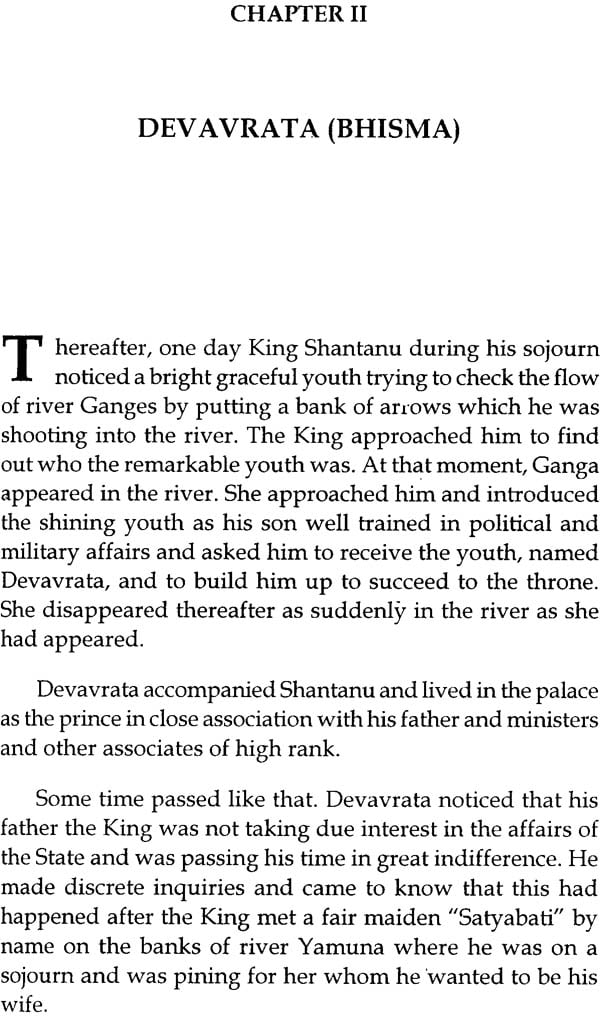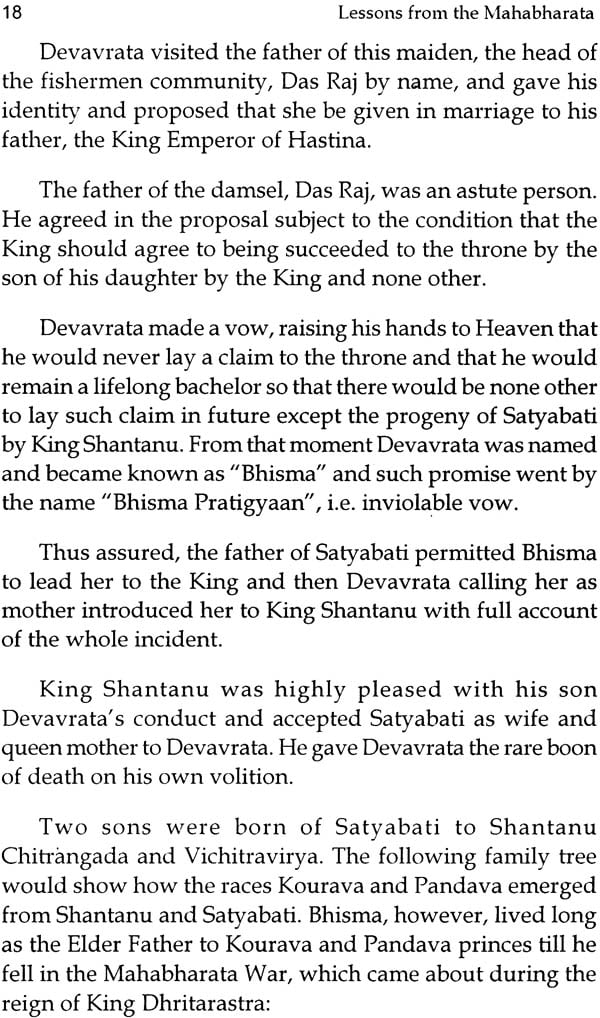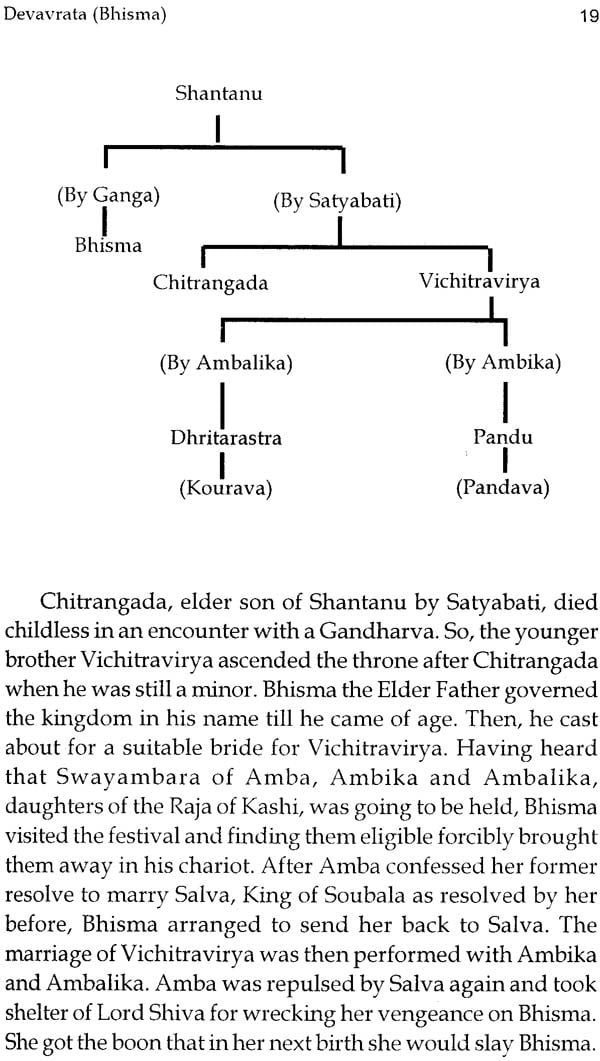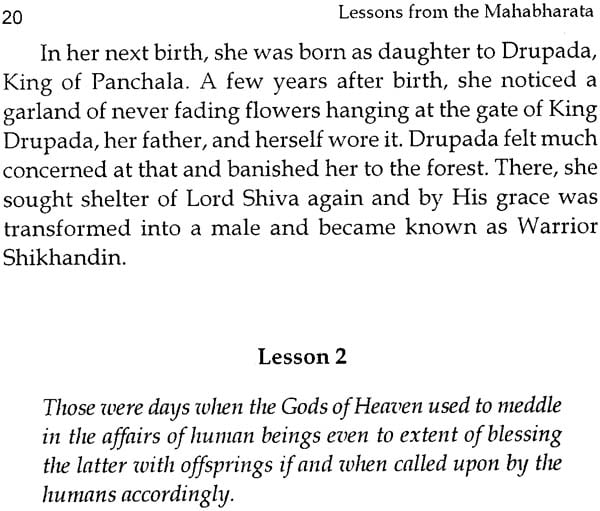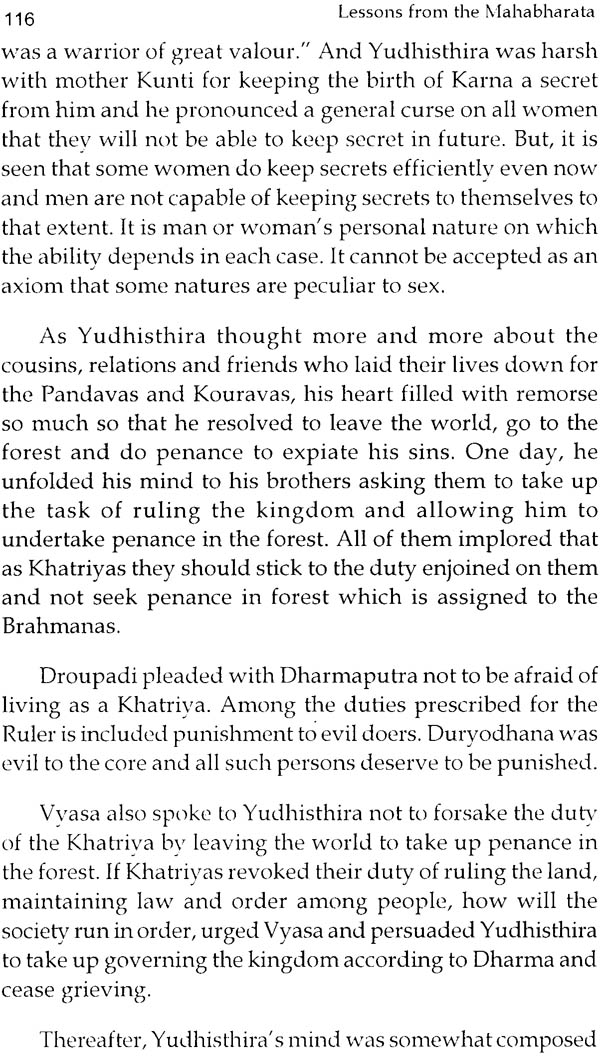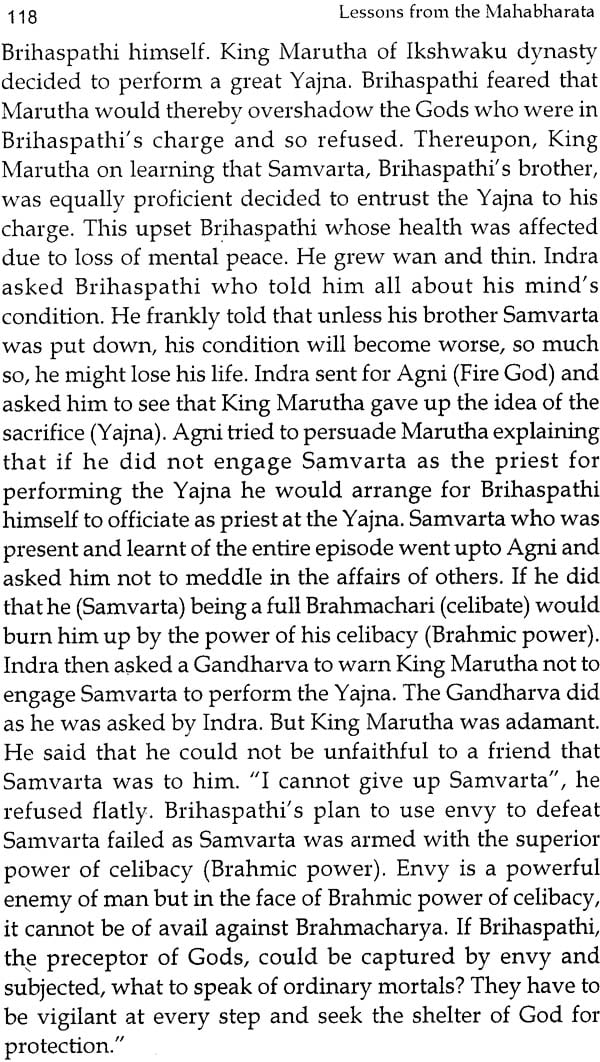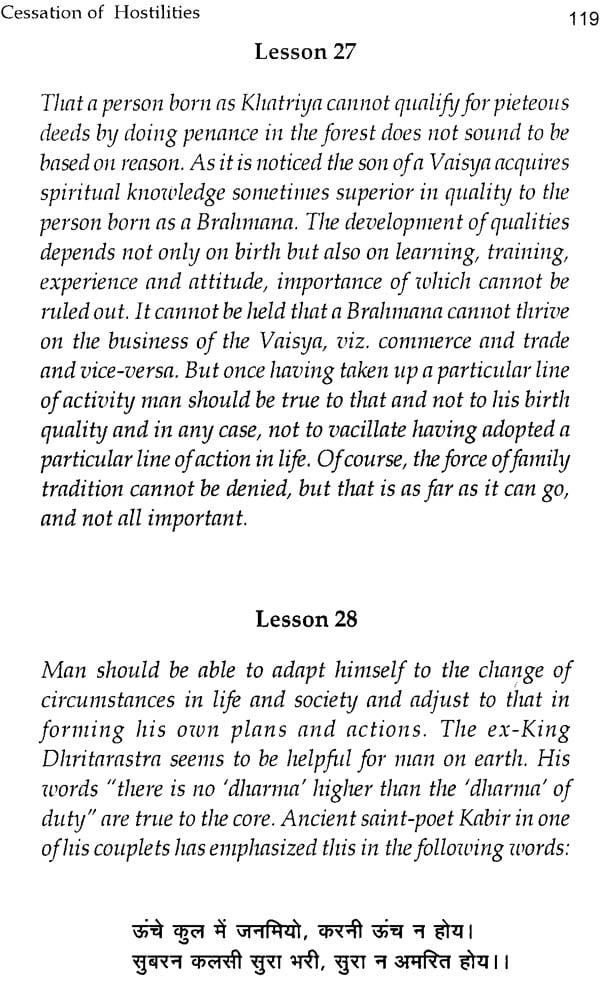
Lessons from the Mahabharata
Book Specification
| Item Code: | IDE118 |
| Author: | G. N. Das |
| Publisher: | ABHINAV PUBLICATION |
| Language: | English |
| Edition: | 1998 |
| ISBN: | 8170173676 |
| Pages: | 151 |
| Cover: | Hardcover |
| Other Details | 8.8" X 5.8" |
| Weight | 340 gm |
Book Description
The story of the Mahabharata is not only of the great war between the Kouravas and Pandavas for a period of eighteen days in the battlefield of Kurukshetra near Delhi.
As a matter of fact the supreme lesson held out by the great Epic is the one with which Vyasa Deva, the author, starts - viz. when men live together as one family they not only thrive, but they exist as a great community or race.
As long as the Pandavas and Kouravas lived together they not only thrived as two great wings of a race but as one and the same race of the Kurus.
As we proceed with the story of the Mahabharata we notice how this was stabilized as long as they lived together with each other.
And we have noticed how the great war reduce the powerful Kurus and decimated them to a struggling few of call themselves as remnants of the great Kuru race.
This holds good not only in the case of few families living together in small units but number of races living in the world culminating in the truth noticed in the maxim "One World One Family" which is the title of the next work by the same author.
The author, Shri Gananath Das, retired from the Indian Administrative Service in the year 1972. Since then he has engaged himself in the study of various saint poets starting with the famous saint poet, Kabir Das, of the 15th century A.D.
On Kabir his works include Life and Philosophy of the Saint Poet in Oriya, and translation of five hundred of his couplets in English Verse, in three volumes: the first of one hundred published by the Bharatiya Vidya Bhavan of Bombay in 1992, the second of three hundred published by Motilal Banarsidass of Delhi in 1991 and the third of one hundred published by Writers Workshop of Calcutta in 1992, followed by Sayings of Kabir published by the same publisher in 1993.
In 1992 he published his translation of one hundred songs of Guru Nanak Dev as 'Nanak Satak' in Oriya and 100 Love Songs of Kabir in English Verse which was published by Abhinav Publications of New Delhi.
In 1994 he published his Oriya Verse translation of the entire Thiru Kural, the immortal work of the Tamil Saint Poet Thiru Valluvar, consisting of 1330 couplets in 133 chapters.
In 1994 he published his Essays on Kabir published by the Writers Workshop of Calcutta consisting of in depth studies of the Saint Poet's Sayings on as many as 22 topics.
In the meantime he has completed his "Readings from Bhagabata", being English Verse translation of over 150 Sayings of the famous scripture originally composed by Vyasa Deva and translated into Oriya Verse by Saint Poet Jagannath Das of 'Pancha Sakha' fame.
The great epic of Mahabharata is regarded in India as the fifth Veda, which has sustained the moral and social fabric of this country for centuries. The multitude of characters, the situations the complexities of human relationships and the high drama in the conflict of the good and evil have sunk deep into the psyche of the people of India to give the myth characteristic outlook and philosophy of life bearing and unmistakable stamp of distinction. Rendered into various languages of the world, the Mahabharata is now a precious component of human heritage on this planet. In India too almost every regional language has its own rendering of this immortal epic. The prose version of the study in English written by Chakravarty Rajgopalachary could easily be counted among the latest attempts to take the Mahabharata to the millions who have no access to the original Sanskrit text.
It is a pleasure to come across yet another running narrative of the central story of Mahabharata in lucid English prose given to us by G.N. Das, who has to his credit an impressive list of literary works mostly based on the time-honoured classics of the country.
Being an octogenarian of wide experience and insight, he seems to have noticed with regret the moral degradation in the present society and therefore, has chosen the daunting task of reviving the deep moral awareness embedded in the literary classics and codes of the country. He has not just despaired at the fall in moral standards, but has quietly taken the positive approach of holding up the ancient value structure before the present generation by laboriously delving into the past. It is a commendable and hopefully rewarding achievement once it reaches the targeted readers of the new generation.
The narrative of Mahabharata in simple prose, acquainting the readers with the mainstream of events was to my mind a fairly satisfying work for any author. But G.N. Das would not stop at that. He has taken up a further task of providing notes to the narrative in the form of lessons, to highlight the moral values and conflicts, which the casual reader is likely to miss in the drift of the narrative. At times, these notes are abstracts and maxims, as in Lesson 1 and at other times, they are observations and commentaries by the author as in Lesson 16. By this method, he takes the reader into close confidence and quietly points and excellence like the expert guide taking a visitor round the magnificent temple of Konark and inviting his attention to the rare touches of the master artist. This method was confined to textbooks. Shri G.N. Das has experimented with it in an altogether different area. I very much wish it in an altogether different area. I very much wish it to serve the purpose it is intended to serve and restore the respect for the values, the present generation has apparently lost.
The great Epic of the Mahabharata as we know from the scriptures was compiled by Vyasa Deva, son of Saga Parasara, after he compiled all the Puranas and completed the division of the Vedas into Ruk, Sama, Jajur and Atharva.Even so, he did not gain peace of mind and satisfaction from his works and he approached and sought the advice of the great Sage Narada.
It was Narada who advised Vyasa to compile one which would give guidance to human being to lead righteous life on earth. Vyasa then took up the compilation of the Mahabharata and compiled it skilfully in as many as eighteen 'Parbas' or 'Book Chapter' That is what promoted me to take up the "Lessons from the Mahabharata" in simple English prose to present to the vast English knowing population particularly the younger generation familiar with the English language widely.
After completing the manuscript as I took a bird's eye view of the lessons thrown up, the one that caught my imagination was which urged human being to "live and let live" , at home , in society , in clan and in the large sphere. It is the one which makes mention of the faggots burning in hearth when put together and when separated getting extinguished and start giving smoke, and when rearranged again to come together to flame up in the hearth.
And I was reminded of the famous lines of the well known English novelist, Gardiner- "The great moments of heroism and sacrifice are rare in life. It is the little habits of common place intercourse that make the great sum of life, and sweeten or make bitter the journey" and I noticed how Vyasa by skilfully juxtaposing the righteous Pandavas with the vicious and wicked Kouravas has pinpointed the lessons the Epic holds for the benefit to the human being in order to lead life of righteousness.
The Story of the Mahabharata is itself a gripping one and the genial reader will notice how it unfolds the lessons in the very corpus thereof. I, therefore, decided to make specific mention of the lessons at the end of the chapters to which they pertain. For instance, Vidura has pointed out in so many words in Chapter V, para 11 in the story itself that the game of dice on wager brings only ruinous results and the parties to the game should not forget that and rush to agree to a second game on wager on the plea of Khatriya tradition. However, it is given in the form of a lesson at the end of Chapter VI of the story.
Similarly, Lesson 7 at the end of Chapter VII emphasises the importnce of imbibing in actual practice what is learnt from scriptures. Man should not be satisfied with acting as a mere stores houses of information. He may not be taken to practice and has not actually practiced that. It is not man's store of Knowledge but his ability to translate that into action that is held correctly as true knowledge.
With the elaborate study in as many as 32 chapters along with 34 lessons appended at the end of the relevant chapters, I believe the reader will find easy access to the lessons held on the Epic.
I shall be grateful to genial reader if he / she kindly take pain to point out inconsistencies, if any, in the work and suggestions for removal thereof.
| Foreword | 7 | |
| Preface | 9 | |
| Acknowledgements | 12 | |
| I | Prologue | 13 |
| II | Devavrata (Bhisma) | 17 |
| III | Karna | 21 |
| IV | Dice Game and Exile of the Pandavas | 25 |
| V | Indraprastha and Hastinapura | 29 |
| VI | Second Dice Game and Exile of the Pandavas | 33 |
| VII | Forest Life of Pandavas | 37 |
| VIII | The Pandavas in Exile | 41 |
| IX | The Pandavas and Kouravas Face Each Other in Battle | 45 |
| X | At Doorstep of Mahabharata War | 51 |
| XI | Efforts for Peace | 55 |
| XII | Shrikrishna's Effort for Peace | 59 |
| XIII | Karna and Kunti Devi | 63 |
| XIV | Selection of Generalissimos | 65 |
| XV | Kurukshetra War Preparations | 69 |
| XVI | Second Day's War | 71 |
| XVII | Fall of Bhisma | 75 |
| XVIII | Under Drona's Leadership | 79 |
| XIX | Kouravas Effort to Capture Yudhisthira - Fall of Abhimanyu | 83 |
| XX | Fall of Drona | 87 |
| XXI | Karna as Generalissimo | 99 |
| XXII | Fall of Duryodhana (Part I) | 103 |
| XXIII | Fall of Duryodhana (Part II) | 109 |
| XXIV | Cessation of Hostilities | 115 |
| XXV | Departure of Shri Krishna | 121 |
| XXVI | The Weasel's Story | 125 |
| XXVII | The Reign of Yudhisthira | 129 |
| XXVIII | Dhritarastra's Vanaprasthya | 133 |
| XXIX | The Days Ahead - Passing of Balarama and Krishna | 137 |
| XXX | The Last Days | 141 |
| XXXI | Conclusion (I) | 145 |
| XXXII | Conclusion (II) | 147 |
| Glossary | 149 |
